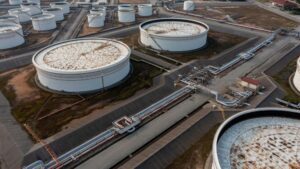There comes a time when every business has to make important capital investment decisions to upgrade infrastructure and position themselves for future growth. One such decision involves determining if above ground storage tanks are right for your operations. While an above ground tank may provide additional storage capacity and environmental benefits, it also represents a major financial investment that must be thoroughly evaluated. As a business owner, you need to determine Cost Benefit Analysis for Aboveground Tanks before installing. By understanding the total cost of ownership and evaluating the potential return on investment, you can make the choice that aligns with your company’s priorities and helps achieve your long term strategic goals. The following cost-benefit analysis of above ground storage tanks will provide the insights and perspective needed to make this crucial decision with confidence.
Upfront Costs: Purchasing and Installation
The initial investment in an above ground storage tank includes the cost of the tank itself as well as storage tank installation. Aboveground Storage Tank prices vary depending on the size, material, and quality. Steel tanks tend to be the most affordable, ranging from $500 for a small 250-gallon tank up to $50,000 or more for a large 50,000-gallon tank. Fiberglass and polyethylene tanks are more expensive, starting around $2,000 for a 250-gallon tank and going up to $100,000 or more for a 50,000-gallon tank.
Installation costs also differ significantly based on the tank size and configuration. The total installation cost for a small 250-500 gallon tank is typically $1,000 to $3,000. Larger tanks, especially those over 10,000 gallons, often require reinforced concrete foundations and additional site preparation which can cost between $10,000 to $50,000 or more for installation. Some locations may require additional permits and inspections which would increase the total upfront costs.
While the initial investment in an above ground storage tank may seem substantial, it is important to consider the potential long-term cost savings and benefits. Larger volume tanks reduce the frequency of refueling or pickups and provide more stable pricing by allowing you to purchase fuel in larger quantities when rates are low. Above ground tanks also have lower maintenance costs compared to underground tanks which require periodic testing and replacement.
Proper budgeting and a comprehensive cost-benefit analysis can help determine if an above ground tank is a worthwhile investment for your needs. Reviewing the expenses for your current fuel storage and distribution system may reveal opportunities for significant savings and efficiency gains with an above ground tank solution. Their durability and longevity, some lasting 30 years or more, also provide many years of reliable service to recoup the initial costs.
Maintenance Expenses: Keeping Your Tank in Working Order
To keep your above ground storage tank in working order, regular maintenance is required. This involves routine inspections, storage tank repairs , and part replacements to prevent costly damage or operational failures.
Aboveground Storage Tank Inspections
It is recommended that above ground tanks undergo regular visual inspections and maintenance , at a minimum of once per month. Look for signs of damage or corrosion to the tank body, valves, piping, seals, and containment area. Check that all parts are securely fastened and there are no visible leaks. If anything seems amiss, consult a certified tank inspection professional.
Seal and Gasket Replacement
The seals and gaskets on an above ground tank, especially those exposed to weather, will deteriorate over time. It is a good rule of thumb to have a certified tank technician replace seals and gaskets every 3-5 years to prevent leaks. Prompt replacement of worn or damaged seals will reduce loss of the tank’s contents and ensure safe operation.
Painting and Coating
The exterior coating of an above ground tank protects the metal from corrosion. Have the tank re-coated according to the manufacturer’s recommendations, typically every 5-10 years. For the coating to adhere properly, the tank surface must be cleaned and primed. Use a coating specifically intended for industrial use.
By following a routine maintenance schedule, you can keep your above ground tank in working order for many years to come. While maintenance does require an initial investment, it will save you money in the long run through avoided part failures, operational disruptions, and lost inventory. With proactive upkeep, your tank will serve you well for decades.
Energy Costs: How Much Will It Cost to Operate?
Operating an above ground storage tank comes with energy costs to consider as part of your cost-benefit analysis. The primary energy expenses stem from heating the tank and fueling the pumps and valves.
Heating Costs
Since above ground tanks are exposed to ambient air temperatures, their contents must be heated to remain in a liquid state. The energy required to heat the tank depends on several factors, including:
- The tank’s material and insulation. Steel and aluminum tanks with proper insulation require less energy than concrete or fiberglass tanks.
- The tank’s size and shape. Larger tanks and those with a higher surface area to volume ratio need more energy to heat.
- The stored liquid’s viscosity and freezing point. Substances with a higher viscosity and lower freezing point, such as crude oil, demand more heating than those with a lower viscosity and higher freezing point.
- Ambient temperature conditions. Colder climates necessitate more heating to maintain an adequate internal tank temperature.
- Desired internal temperature. The higher the target temperature, the more energy is needed to reach and sustain it.
Heating costs are often one of the largest operational expenses of above ground tanks, so carefully evaluating these factors can help determine if heating requirements fit within your budget. Alternative heating methods, like heat tracing and insulation jackets, may help reduce costs.
Pumping and Valve Costs
Moving liquids in and out of the tank requires energy to power the pumps, valves, meters, and related equipment. The energy consumption of this equipment depends on the number of components and their efficiency ratings. More frequent loading and unloading also increase associated energy costs. Choosing high-efficiency, properly sized equipment and minimizing excess pumping and valving can help lower energy usage and costs.
Cost vs Utility
When determining if above ground storage tanks are right for your needs, it is important to weigh the costs versus the benefits. While above ground tanks typically have higher upfront costs, they can provide additional utility over time.
The initial purchase and installation of above ground tanks tends to cost more than underground tanks. Above ground tanks require a concrete base and more robust construction to withstand environmental exposure. However, above ground tanks also provide easier monitoring and access for inspections and repairs. Routine maintenance and any necessary repairs can be performed without excavation, reducing ongoing costs.
Above ground tanks may also qualify for additional safety mechanisms like emergency relief vents, foam fire suppression systems or dikes for spill containment. These safety features provide environmental and operational benefits that help avoid unforeseen costs from leaks, spills or other incidents.
Regular maintenance and monitoring of above ground tanks allows for identification of potential issues early on. This can help avoid emergency repairs and limit the impact of any incidents. While underground tanks require specialized monitoring and testing equipment to identify issues, above ground tanks can often be visually inspected.
When evaluating the total cost of ownership, the initial investment in higher quality, safer above ground tanks may provide a strong return on investment over the lifetime of the tanks. The easier access, monitoring and maintenance of above ground tanks helps avoid unplanned costs and limit environmental risks. For many operations, above ground tanks are a cost-effective solution that provides additional utility and peace of mind.
In summary, while above ground storage tanks often come with higher upfront costs, their long-term benefits related to safety, monitoring and maintenance frequently provide a strong return on investment. By reducing ongoing and unforeseen costs over time, above ground tanks can be a cost-effective choice for storage needs.
Depreciation and Replacement: How Long Do Above Ground Tanks Last?
Above ground storage tanks have a limited lifespan and will eventually need to be replaced. As an asset, the value of an above ground tank depreciates over time. Understanding the rate of depreciation and average replacement timelines can help determine if the initial capital investment in a new tank will provide a good return.
The typical useful life of an above ground tank is 15 to 30 years, depending on factors like material, coatings used, environmental conditions, and frequency of use. Steel tanks tend to last 20-30 years, while fiberglass tanks are on the shorter end of the range. More corrosive substances stored and extreme weather conditions can also reduce tank lifespan.
Depreciation
Above ground tanks depreciate in value over time. The depreciation rate depends on the tank cost, useful life, and salvage value. Using the straight-line depreciation method, if a $50,000 tank has a 20-year useful life and $5,000 salvage value, it would depreciate at $2,250 per year. After 10 years, the tank value would be $25,000. Depreciation reduces tax liability but also means less value to leverage or recover costs.
Replacement Cost
When it’s time to replace a tank, the total cost will depend on the size, material, and features of the new tank. Installation, permitting, and disposal of the old tank can add 30-50% to the base tank price. If costs have risen with inflation, the replacement tank may be significantly more expensive than the original purchase price, impacting project ROI.
To determine if an above ground tank will provide a good return on investment, evaluate the depreciation rate, expected useful life, replacement cost, and ongoing maintenance requirements. While depreciation reduces tax burden, the eventual replacement cost must still be accounted for to properly assess total lifecycle costs. For high-volume or hazardous material storage, above ground tanks can still prove very cost-effective compared to other options.
Additional Considerations: Environmental and Safety Factors
When considering above ground storage tanks, it’s important to weigh the environmental and safety factors in your cost-benefit analysis. Protecting the surrounding area and anyone who interacts with the tanks should be a top priority.
Some key things to consider:
- Containment measures: Double-wall tanks provide an extra layer of protection from leaks and spills. Concrete containment walls or steel berms around single-wall tanks can also effectively contain a tank failure.
- Monitoring systems: Constant digital monitoring systems can detect even minor leaks and changes in pressure to alert operators right away. Automated systems are useful for remote tank locations.
- Spill response plans: Detailed emergency plans for responding to spills, leaks, fires and other disasters can minimize damage. Training employees and testing response plans regularly helps ensure maximum preparedness.
- Permits and regulations: Following all federal, state and local regulations regarding above ground storage tanks is essential to avoiding legal issues, fines and other consequences. Permits and inspections may be required, especially for tanks containing hazardous materials.
- Security: Restricting access to tanks, especially those containing flammable or toxic materials, is important for safety and vandalism prevention. Locked entry points, security cameras, motion-activated lights and frequent patrols help secure the area.
While the upfront costs for these environmental and safety measures may seem high, the potential long term costs of contamination, health issues, fines and lawsuits far outweigh them. For communities near tank installations, implementing the proper containment and monitoring systems can provide peace of mind and help facilitate approval of the project. For tank owners and operators, a safe and compliant installation is the responsible and ethical thing to do. Considering environmental and safety factors in the early planning stages of any above ground storage tank project leads to the most cost-effective and community-friendly outcome.
Conclusion
You have now reviewed the key factors to consider when evaluating the total cost of ownership for above ground storage tanks. While the initial capital investment may seem high, the long-term benefits to your operations can make above ground tanks a worthwhile investment. By reducing environmental and safety risks, decreasing maintenance demands, and maximizing the useful life of your storage equipment, above ground tanks provide both financial and operational advantages over time. As with any major equipment purchase, conduct a thorough cost-benefit analysis based on your specific needs and priorities. If designed and installed properly, above ground tanks can provide decades of safe, reliable, and cost-effective liquid storage and handling for your business. The choice is clear: for storage solutions that stand the test of time, think above ground.




